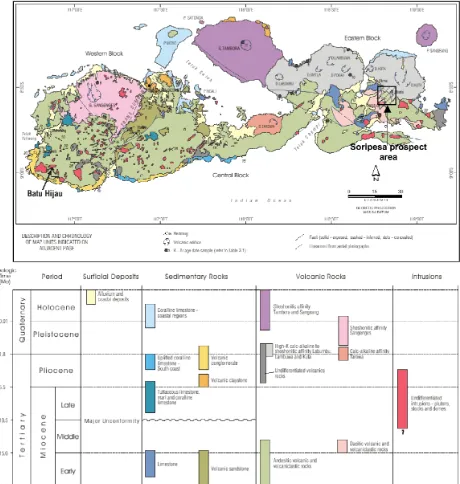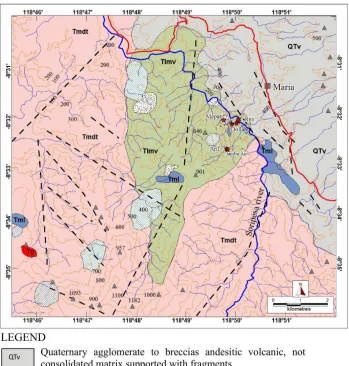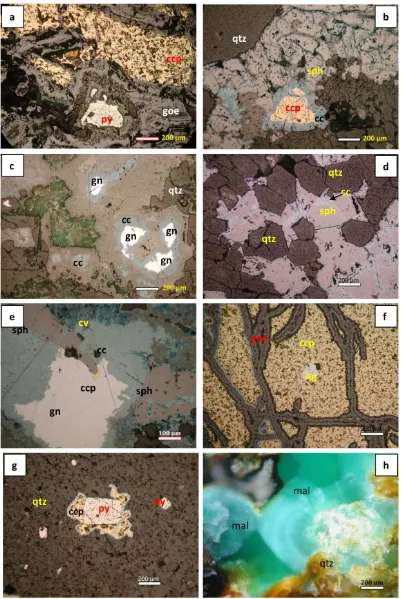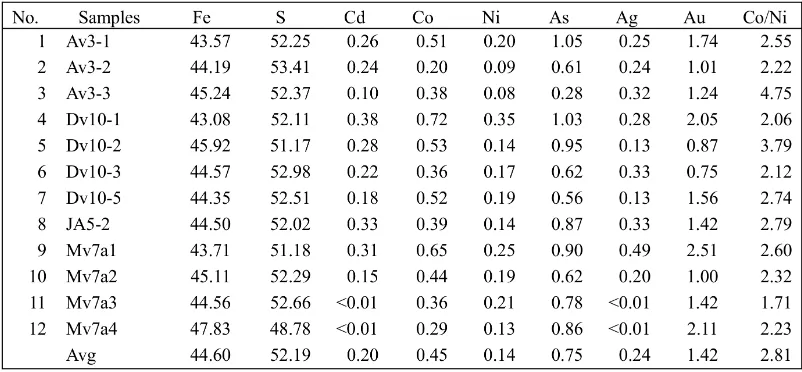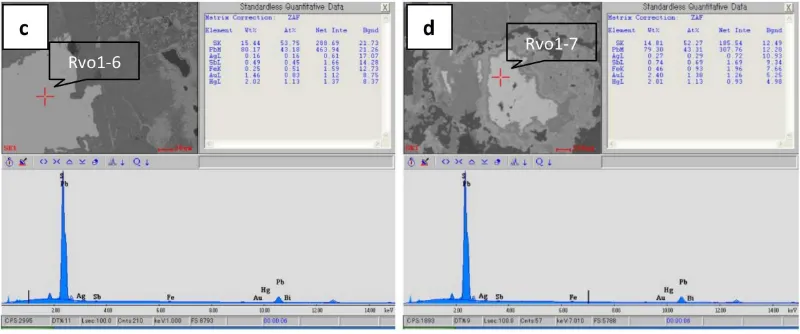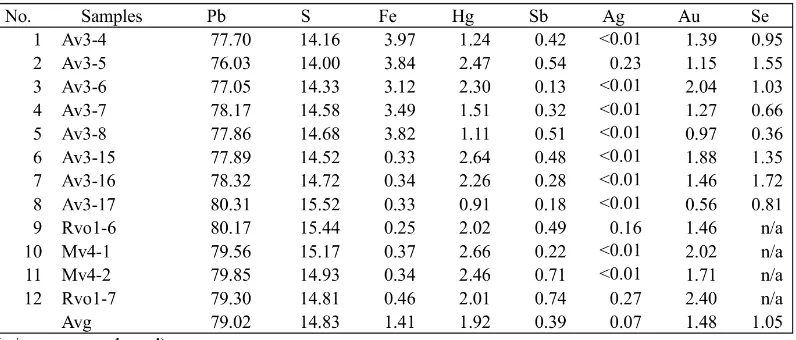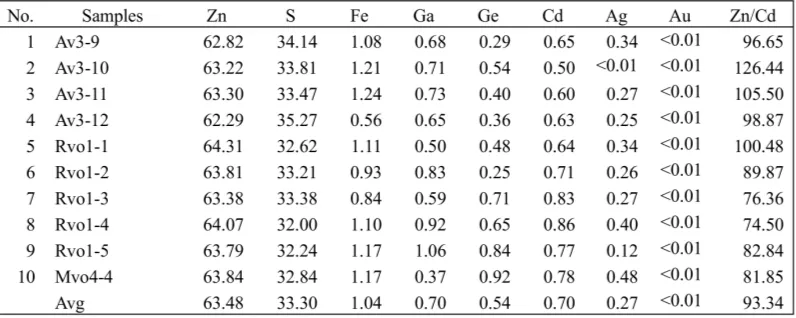ORE MINERALOGY AND MINERAL
CHEMISTRY OF PYRITE, GALENA, AND
SPHALERITE AT SORIPESA PROSPECT AREA,
SUMBAWA ISLAND, INDONESIA
Win Kant∗1,2, I Wayan Warmada1, Arifudin Idrus1, Lucas Donny Setijadji1, and Koichiro Watanabe3
1Department of Geological Engineering, Gadjah Mada University, Yogyakarta, Indonesia 2Department of Geology, Banmaw University, Myanmar
3Department of Earth Resource Engineering, Kyushu University, Japan
Abstract
The Soripesa prospect area is located at Maria vil-lage, Wawo district, Bima region in the East Sum-bawa Island, Indonesia. Lithology is dominantly composed of a lithic-crystal tuff of andesitic and dacitic composition and bedded limestone. The poly-metallic epithermal quartz veins are hosted by an-desitic volcaniclastic rocks. Within these veins, mul-tiphases, colloform-crustiform, bedding to massive textures with pyrite, sphalerite, galena, chalcopy-rite, chalcocite, azuchalcopy-rite, and malachite are observed. Selected samples were analyzed by using ore mi-croscopy and SEM-EDX. Ore minerals show re-placement, ex-solution, colloform, and zonal tex-tures. The paragenesis diagram was made from a careful study of polished sections and thin sections. Textures of ore minerals such as banded, exsolution, replacement, and zone, have been interpreted to cor-respond to the order of deposition. In pyrite, the av-erage content of Co (0.45 wt.%) is higher than Ni content (0.14 wt.%) and it means that their origin may be hydrothermal origin. Average content ratio, Co:Ni is 2.81. Galena shows a low Ag content of 0.07 % in average. But they show a high Au content of 1.48 % in average. Sphalerite shows a low Fe con-tent of 1.04 % in average and occasionally
chalcopy-∗Corresponding author: W. KANT, Department of Geological Engineering, Faculty of Engineering, Gadjah Mada University, Jl. Grafika 2 Yogyakarta, 55281, Indone-sia. E-mail: winkant1995@gmail.com
rite inclusion/disease also occurred. Ga and Ge con-tents are also high in sphalerite. Co>Ni in pyrite,
low content of Ag in Galena, low content of Fe and mole % FeS in sphalerite, high content of Ga and Ge, and log (Ga/Ge) in sphalerite, show that pyrite, galena, and sphalerite from Soripesa prospect area were formed under low temperature condition of hy-drothermal fluid.
Keywords: Ore textures, paragenesis, deposition, hydrothermal fluid, low temperature
1 Introduction
The Soripesa prospect area is located in Maria village, Wawo district, Bima regency, West
Nusa Tenggara Province. The prospect area
is previously owned by PT Bima Baruna Raya Mining (BBRM) and PT Sumbawa Timur Min-ing. These companies have observed Au-Ag
deposit and base metal mineralization. At
present, PT Bima Putera Minerals (Indomin-ing Group) has a Min(Indomin-ing Permit (exploration stage) for those deposits. The prospect area is mainly composed of andesitic and dacitic volcaniclastic host rocks and small amount
of Tertiary bedded limestones. There have
of those veins are chalcopyrite, galena, spha-lerite, pyrite, chalcocite, covellite, azurite, and malachite, which are forming as polymetallic epithermal quartz veins.
The purpose of this paper is to identify the ore mineral paragenesis and ore forming pro-cesses, and mineral chemistry of some sul-fide minerals, especially for pyrite, galena, and sphalerite from polymetallic epithermal quartz veins at Soripesa prospect area, East Sumbawa, Indonesia.
2 Regional Geology
The Sumbawa Island forms as a part of the Cenozoic calc-alkaline volcanic inner Banda-Sunda Arc which is still active up to present. Sunda-Banda island arc is a volcanic arc formed by the interaction of plate subduction slab in the form of Indo-Australia with Asian plate (Carlile and Mitchell, 1994). Sunda-Banda arc is the longest in Indonesia, extending from north Sumatra through Java, Bali, Lombok, and
Sum-bawa, to east Damar. The shape of the
is-land arc is now being modified in the east due to collision with the Australian–New Guinea continental margin, including East Sumbawa (Hamilton, 1974).
The Sumbawa Island is mainly composed by andesitic to basaltic lava and breccia of the Lower Miocene, with intercalations of tuff and limestone, fresh pyroclastic sequences and shoshonite. This sequence is overlain in parts by dacitic tuff and bedded limestone of the Mid Miocene. These units have been intruded by numerous small to medium bodies (several km’s) in the Middle to Upper Miocene includ-ing andesite, dacite, diorite, trachyte and
syen-ite (Figures 1 and 2). Sumbawa Island,
re-gionally, is intersected by NW-SE and NE-SW trending structures. However, the formation of quartz veining, alteration and mineralization at Soripesa Prospect are related to the N-S faulting
(Noyaet al, 2009).
3 Sampling and Analytical Methods
Eighteen selected samples were made thin sec-tions and polished secsec-tions to identify the ore
minerals and their textures. Ore textures and ore mineral assemblages are analysed under ore microscopy at Earth Resource Engineering De-partment, Kyushu University. An Energy Dis-persive X-Ray Analyser (EDX or EDA) is also used to provide elemental identification and
quantitative compositional information. For
SEM-EDX analyses, 15 polished sections and 3 thin sections were used to identify the mineral chemistry by using a SHIMADZU SS-550 SEM with a Genesis 2000 energy dispersive spec-trometer (EDX) at the Center of Advanced In-strumental Analysis, Kyushu University. Semi-quantitative analyses were performed at an ac-celerating potential of 15 kV, with a beam
cur-rent of about 6.0×10−10 A, and a beam
diam-eter of 3µm. All the data were corrected with
a ZAF matrix-correction program. The low-est detection limit is 100 ppm. Ore minerals such as sphalerite, galena, pyrite, chalcopyrite, chalcocite, azurite, malachite, oxide minerals, and some unknown minerals were analyzed by SEM-EDX for elemental identification and com-positional information. Based on the elemen-tal compositions, ore minerals can be estimated and identified their ore genesis, and ore form-ing processes.
4 Results and Discussions
4.1 Ore Minerals Assemblages and Their Textural Characteristics
Common ore minerals of the polymetallic ep-ithermal quartz veins at Soripesa prospect area
are chalcopyrite [CuFeS2], galena [PbS],
spha-lerite [ZnS], azurite, malachite, chalcocite,
cov-ellite, pyrite [FeS2], hematite, and other
iron-oxide minerals.
Figure 2: Geological map of around Soripesa prospect area with epithermal quartz veins (modified
Pyrite. most of pyrite occurs as euhedral form and some are replaced by chalcopyrite. Pyrite occurs in both host rock samples and vein sam-ples. Some are replaced by Fe oxide minerals such as goethite and hematite which are show in concentric texture (Figure 3a). Some pyrite minerals show ribbon texture.
Galena. galena is one of common ore miner-als in this research. Some of galena shows a typ-ical texture of triangular pits (Figure 3c). Most of the crystal outlines of galena are generally re-placed by chalcocite (Figures 3c and 3e).
Sphalerite. sphalerite is also a common ore mineral of polymetallic epithermal quartz veins in this research area. Most of sphalerite show intergrowth texture with oriented an unori-ented inclusions of chalcopyrite (the so-called “chalcopyrite disease”; Barton, 1978). Tradi-tionally, the texture has been described as an ex-solution of chalcopyrite from sphalerite. How-ever Barton (1970, 1978) and Kalogeropoulos (1982) have convincing evidence that “chal-copyrite disease” is a cancerous replacement produced by Cu in aqueous solution reacting with FeS in sphalerite. In some case, the out-lines of sphalerite minerals are in general con-cave toward quartz minerals (Figure 3d). It means that sphalerite is younger than quartz in order of deposition. Sphalerite shows a lot of cracks which are replaced by chalcocite and covellite
Chalcocite. they are found as replacement minerals and replace sphalerite, chalcopyrite, and galena (Figures 3b-e). In some case, they show colloform textures.
Covellite. they also occur as replacement minerals and replaced mainly in chalcocite. Azurite and malachite are found as hydrother-mal alteration minerals. Some azurite shows zonal texture under ore microscopy (Figure 3e).
4.2 Ore-gangue Minerals Paragenesis
The paragenesis for a mineral deposit or a ge-netically related group of deposits is inferred
from the mutual relationships among the min-erals and assemblages (Misra, 1999). The inter-pretation of microscopic textures of ore miner-als is very useful to prepare the paragenesis di-agrams of those ore minerals. The paragene-sis was made from a careful study of polished sections and thin sections. Textures of ore min-erals such as banded, exsolution, replacement, and zone, have been interpreted to correspond to the order of deposition. Pyrite and quartz minerals show their euhedral crystal form. It is clear that sphalerite is younger than quartz in order of deposition (Figure 3d). In Figure 3e, it can be seen clear that covellite replace chal-cocite, and chalcocite commonly coats and re-places the margins of galena and sphalerite, and sphalerite replace galena. Chalcopyrite inclu-sions also occur as exsolution textures in crys-tallographic direction of sphalerite (Figure 3e). Fe oxide minerals replace in the cracks of chal-copyrite and pyrite (Figures 3a and 3f). Azurite and malachite occurs as later phase minerals.
Based on the textural characteristics, order of deposition can be divided in to two phases as early phases and later phases. Quartz, galena, pyrite, sphalerite, and chalcopyrite are formed in early stage of deposition. Chalcocite, cov-ellite, azurite, malachite, and Fe oxide miner-als are formed later phase of ore deposition. The paragenesis of a mineral deposit can pro-vide a record of the local changes in geochemi-cal parameters (T, P, fluid composition, etc.) in the course of mineralization (Bastin, 1955). The paragenesis diagrams of ore and gangue min-erals from polymetallic epithermal quartz veins at Soripesa prospect area are shown in Figure 4.
4.3 Mineral Chemistry of Pyrite, Galena, and Sphalerite
Minor Elements in Pyrite
Figure 4: Paragenetic diagram of ore-gangue minerals assemblage of polymetallic epithermal quartz veins at Soripesa prospect area.
Figure 5: Elemental composition and peak intensity of some pyrite minerals detected by SEM-EDX analyses.
Table 2: Geometric means of cobalt (Co) and nickel (Ni) contents (in ppm) and Co:Ni ratios of sediment, hydrothermal, and massive sul-phide pyrite minerals (Xuexin, 1984).
their image, result of element composition (nor-malized wt.%) and peaks of elements (Figure 4). Xuexin (1984) mentioned a statistically signif-icant difference among sedimentary, hydrother-mal (replacement veins), and massive sulfide pyrites (Table 2). According to his study, the massive sulfide pyrites are characterized by a Co:Ni ratio between 5 and 50; hydrothermal pyrites by a variable Co:Ni ratio (often less than 5); and sedimentary pyrites by a much lower
Co:Ni ratio (typically <1). Pyrite from
sul-fide ore deposits generally contains appreciable
amounts of cobalt and has Co>Ni.
According to Carstens (1942), pyrite of sed-imentary origin is characterized by
contain-ing less than 100 ppm cobalt and Co<Ni,
whereas pyrite of hydrothermal origin has
400-2400 ppm cobalt and Co>Ni. Pyrite from
high-temperature deposits is generally high in cobalt, but noted exceptions and considered that the effect of temperature was slight. In this research, average content of Co (0.45 wt.%) is higher than Ni content (0.14 wt.%) and it means that their origin may be hydrothermal origin. Pyrite of high-temperature and hydrothermal sulfide deposits has only a slightly higher av-erage nickel content than pyrite of sedimentary origin and the ranges of concentration overlap. Hawley (1952) found that Ni content was a little higher in high-temperature samples. Average ratio for Co/Ni is 2.81. The Co/Ni ratios for volcano-hydrothermal, metamorphosed vol-canogenic and skarn-hydrothermal pyrites are
in the range of 2–3 (Xuexin, 1984). It means that pyrites from Soripesa prospect area may be formed under the hydrothermal condition.
There is a correlation between As and S, and no correlation between As and Fe in pyrite of
this research (Figures 7a-b). These relations
indicate substitution of As for S in the pyrite structure, as would be expected for pyrite
con-taining As1−(Deditiuset al, 2009). There is also
a correlation between Au and Ag but no corre-lation between Au and As (Figures 6a-b).
Minor Elements in Galena
Galena is also common ore minerals of epither-mal quartz veins in this research area. 16 galena minerals were detected by SEM-EDX for their mineral chemistry. Some detected minor ele-ments of galena from this research are Fe (1.4 wt.%), Hg (1.92 wt.%), Ag (0.07 wt.%), Au (1.48 wt.%), Sb (0.39 wt.%), and Se (1.05 wt.%) (Table 3). SEM image, peaks of elements, and results of element composition (normalized wt.%) of some Galena analysed by SEM-EDX are shown in Figure 8.
Tischendorf (1955) found that the antimony content (present at least in part as tetrahedrite) decreased with decreasing temperature of for-mation. Schroll (1955) considers the presence of bismuth in galena to be a mark of high-temperature magma-near deposits. Galena in this research has below detection limit of bis-muth. Schroll (1955) found that the content of silver varied directly with those of antimony and bismuth and inversely with content of ar-senic. Fleischer (1956) reported that the content of silver, bismuth, and antimony are decreased with decreasing temperature of formation. Sil-ver content (0.07) is Sil-very low and it means that galena from this research may be formed in de-creasing temperature of formation.
Minor Elements in Sphalerite
spha-Figure 6: Plots showing correlation diagrams of Au, Ag, and As concentration in pyrite.
Figure 7: Plots showing correlation diagrams of As, S, and Fe concentration in pyrite.
Table 3: SEM-EDX analyses of element composition (wt.%) of galena. Element composition (nor-malized wt.%) of Galena minerals.
lerite are Fe (1.04 wt.%), Ga (0.7 wt.%), Ge (0.54 wt.%), Cd (0.7 wt.%), and Ag (0.2 wt.%). Au content is below detection limit in all sphalerite (Table 4). Figure 9 show the result of some spha-lerite minerals analysed by SEM-EDX. The re-sults show SEM image, peaks of elements, and elemental composition in wt.%.
Jonasson and Sangster (1978) investigated the Zn/Cd ratios of sphalerites from some sul-phide ores in Canada and concluded that the Cd contents and Zn/Cd ratios in sphalerites vary with the genetic types of deposit. The Zn/Cd ratios (average 93.34) in sphalerite from the Soripesa prospect area are close to Zn/Cd ratios (104–214) of sphalerites from hydrother-mal deposits and skarn-hydrotherhydrother-mal deposits. Stoiber (1940) and Schroll, (1955) considered that the gallium content is most likely to be high in sphalerites from low-temperature deposits such as those of Mississippi Valley type and in those from low-temperature quartz veins.
In this research, average Ga content (0.7 %) in sphalerites is very high and it means that they may be formed under low temperature condition. Many investigators agree that spha-lerite from low-temperature deposits to be higher in germanium content than those from mesothermal or high-temperature deposits (Stoiber, 1940; Warren and Thompson, 1945, Fleischer, 1999). In this research, average con-tent of Ge (0.54%) is also very high. Vaughan and Craig (1997) suggested that a zinc
concen-trate from a pyritic ore may contain 61-63 wt.% Zn, but a concentrate from a pyrite-pyrhotite ore will often contain only 51-58 wt.% zinc and be considerably less valuable. The aver-age content of Zn (63.48 wt.%) in sphalerite of this research may be related with pyritic ore condition.
Sphalerite Geothermometry and Geobarometry
A very interesting recent development is the Ga/Ge geothermometer using sphalerite (Moller, 1985). Ga/Ge can be used to deter-mine temperatures in the source regions of ore solutions and to estimate the degree of mixing of hot parental ore fluids with cool, near sur-face waters (Evans, 1993). Ten samples were simultaneously detected levels for these two
elements. The application of these
geother-mometer results of calculating the logarithm follows:
log[(Ga/Ge)f log[(Ga/Ge)sph] (1)
Note that: f = mineraliser fluid; sph = spha-lerite.
metamor-Figure 9: Elemental composition and peak intensity of some sphalerites detected by SEM-EDX analyses.
phism. The chart shows the values of
tempera-tures between 180 to 240◦C. Figure 10 presents
the projection of the respective analysis chart that correlates the race Ga/Ge with the temper-ature. This graph is based on geothermometers known systems of Al/Si and published data for reasons of Ga/Ge in many geological systems (M ¨oller, 1985; 1987).
Neiva (1956) considers that the presence of Ge is higher in sphalerites that are formed at low temperature. Based on the fluid inclusion data from quartz (host minerals), ranges of ho-mogenization temperature for quartz veins is
between 180 and 300◦C (Khantet al, 2012a). The
temperature differences observed between the two geothermometers can be related to the mix-ing and circulation of fluids late and/or pre-fluid surface (M ¨oller, 1985; 1987).
Kullerud (1953) suggested that the FeS con-tent of sphalerite gave a direct measurement of its temperature of deposition. Average Fe content (1.04 %) of sphalerite in this research is very low. Mole % FeS in sphalerite is also very low and between 1–2 %. In Zn-Fe-S of low pressure system, this value (1–2 %) falls in pyrite field (Figure 11). Within the pyrite field the decrease in FeS content of sphalerite with
increasing aS2 (sulfur activity) is much greater
resulting in a close spacing of isopleths near the pyrite-pyrrhotite buffer and in very low
FeS contents in sphalerite at high, aS2 (10
−10
to 10−11). It is commonly found that
spha-lerites formed at high aS2 have a honey yellow
to light brown colour with their low FeS
con-tents whereas sphalerites formed at low aS2 and
within the pyrrhotite field are dark brown to black (Scott, 1983). Those factors mean they may be formed in low temperature condition.
5 Conclusion
Common ore minerals of the polymetallic ep-ithermal quartz veins at Soripesa prospect area
are chalcopyrite (CuFeS2), galena (PbS),
spha-lerite (ZnS), azurite, malachite, chalcocite,
cov-alite, pyrite (FeS2), hematite, and other Fe oxide
minerals. Common textures of ore minerals are replacemnent, exsolution, banded (colloform-crustifom), and zone textures. The
paragene-sis diagram was drawn from a study of pol-ished sections and thin sections under micro-scope. Ore mineral textures have been inter-preted to identify the order of deposition and to made paragenesis diagram. Quartz, pyrite, galena, sphalerite and chalcopyrite are formed in early stage and chalcocite, covelite, azurite, malachite, and Fe oxide minerals are formed in late stage of order of deposition.
Pyrite, galena, and sphalerite are analysed by SEM-EDX to know the elemental compo-sitions. Average contents (wt.%) of some mi-nor elements of pyrite are Cd (0.2), Co (0.45), Ni (0.14), Ag (0.24), Au (1.42), and As (0.75). Some detected minor elements of galena from this research are Fe (1.4 wt.%), Hg (1.92 wt.%), Ag (0.07 wt.%), Au (1.48 wt.%), Sb (0.39 wt.%), and Se (1.05 wt.%). Detected minor elements in sphalerite are Fe (1.04 wt.%), Ga (0.7 wt.%), Ge (0.54 wt.%), Cd (0.7 wt.%), and Ag (0.2 wt.%). Average content of Co (0.45) is higher than Ni content (0.14) and average ratio for Co/Ni is 2.81 in pyrite from this research. It means that origin of pyrite from this research may be hy-drothermal origin. Based on the low contents of Sb, Bi, and Ag in average, we can conclude that galena from this research are formed in de-creasing temperature of formation.
The Zn/Cd ratios (average 93.34) in spha-lerite from the Soripesa prospect area are close to Zn/Cd ratios (104–214) of sphalerites from hydrothermal deposits. Low content of Fe, and high content of Ga and Ge, also indicate that sphalerites from this research are formed in low
temperature quartz veins. Based on Ga/Ge
geothermometer, the formation temperatures of sphalerites can be estimated and they may be
formed at between 180 and 240◦C. 1 to 2 Mole %
FeS in sphalerite indicate that ore deposition
formed under high aS2 (10
−10 to 10−11) and
as-sociated with pyrite field.
Acknowledgement
per-Figure 10: Graph showing the dependence between Ga/Ge ratios in sphalerite and formation tem-perature. This graph is based on existing Al/Si geothermometers. The musc-clo-qtz line is the chlorite geothermometer in the Si/Al system (M ¨oller, 1985; 1987).
mission during the field work. Finally, the au-thors wish to thank Earth Resources Engineer-ing Department, Kyushu University for per-forming laboratory works and analyses.
References
Barton, P.B., Jr. (1978) Some ore textures involving sphalerite from the Furutobe Mine, Akita Prefec-ture, Japan, Mining Geology 28: 293–300.
Barton, P.B., Jr. (1970) Mineral Society of America, Special Paper 3: 187–198.
Barton, P.B., Jr. and Toulmin, P. III. (1966) Economic Geology 61: 815–849.
Bastin, E.S. (1955) Interpretations of ore textures, The Geological Society of America, Memoir 45, 101p.
Carlile, J.C. and Mitchell, A.H.G. (1994) Magmatic arcs and associated gold and copper mineraliza-tion in Indonesia, Journal of Geochemical Explo-ration 50: 91–145.
Carstens, C.W. (1942) Uber den Co-Ni-Gehalt norwegischer Schwefelkies-vorkommen: Kgl. Norske Videnskabs, Selgkabs, Forh. 15: 165–168. Deditius, A.P., Utsunomiya, S., Kesler, S.E., Ewing,
R.C., and Walshe, J. (2009) Behaviour of trace ele-ments in arsenian pyrite in ore deposits, The 10th Biannual Meeting of SGA, Townsville, 17–20 Au-gust. Smart Science for Exploration and Mining 1–2, p. 710–712.
Evans, A.M. (1993) Ore Geology and Industrial Min-erals: An Introduction, Blackwell scientific publi-cations, 3rd Ed., 390p.
Fleischer, M. (1956) Minor Elements in Some Sulfide Minerals? Economic Geology, 50th Anniversary Volume, p. 970–1024.
Garwin, S. (2002) The Geologic Setting of Intrusion-Related Hydrothermal Systems near the Batu Hi-jau Porphyry Copper-Gold Deposit, Sumbawa, Indonesia. Global Exploration 2002: Integrated Methods for Discovery, Colorado, USA, 9, p. 333– 366.
Hamilton, W. (1974) Tectonics of the Indonesian re-gion. U.S. Geol. Surv., Prof. Pap. 1078p.
Hawley, J.E. (1952) Spectrographic studies of pyrite in some Eastern Canadian mines, Economic Geol-ogy 47: 260–304.
Jonasson, I.R. and Sangster, D.F. (1978) Zn:Cd ra-tios for sphalerites separated from some Cana-dian sulphide ore samples, Paper Geol. Surv. Canada 78-1B: 195–201.
Kalogeropoulos, S.I. (1982) Chemical sediments in the hanging wall of volcanogenic massive sulfide deposits. Ph.D. thesis, Univ. Toronto, 488 p. Khant, W., Warmada, I W., Idrus, A., Satijadji,
L.D., and Watanabe, K. (2012) Fluid Inclusion Study on Polymetallic Epithermal Quartz Veins at Soripesa Prospect Area, Sumbawa Island, In-donesia. Journal of Southeast Asian Applied Ge-ology (in preparation).
Kullerud, G. (1953) The FeS–ZnS system: a geologi-cal thermometer. Nor. Geol. Tiddskr. 32: 61–147. Misra, K.C. (1999) Understanding Mineral Deposits,
Kluwer Academic Publisher, 758p.
M ¨oller, P. (1985) Development and application of the Ga/Ge-Geothermometer for sphalerite from sed-iment hosted deposits, In Germann K. (ed.), Geo-chemical aspects for Ore Formation in Recent and Fossil Sedimentary Environments, p. 15–30. M ¨oller, P. (1987) Correlation of
Homogeniza-tion Temperatures of Acessory Minerals from Sphalerite-bearing Deposits and Ga/Ge Model Temperatures, Chemical Geology 61: 153–159. Noya, Y., Effendhy, O., Hamdan Abidin, Z., and
Pakaya, Y. (2009) Geological background and eco-nomic prospect of the Soripesa deposit, eastern Sumbawa, Proceeding pit IAGI Semarang, 2009. The 38th IAGI annual Convention and Exhibition Semarang, 13-14, October.
Scott, S.D. (1983) Chemical behavior of sphalerite and arsenopyrite in hydrothermal and metamor-phic environments. Mineralogical Magazine 47: 427–435.
Schroll, E. (1955) Uber das Vorkommen einiger Spurenmetalle in Blei-Zink-Erzen der ostalpinen Metallprovinz, Tshermaks Mineralog, Petrog, Mitt. 5: 183–208.
Stoiber, R.E. (1940) Minor elements in Sphalerite, Economic Geology 35: 501–519.
Tischendorf, G. (1955) Paragenetische und tek-tonische Untersuchungen auf Gangen des fluo-rbarytischen bleiformation Freibergs, Freiberger Forschungshefte, C18: 1–129.
Vaughan, D.J. and Craig, J.R. (1997) Sulfide Ore Min-eral Stabilities, Morphologies, and Intergrowth Texture, In Barnes H.L. (ed.) Geochemistry of Hy-drothermal Ore Deposits, John Wiley & Sons, p. 367–434.
Warren, H.V. and Thompson, R.M. (1945) Spha-lerites from western Canada. Economic Geology 40: 309–335.
